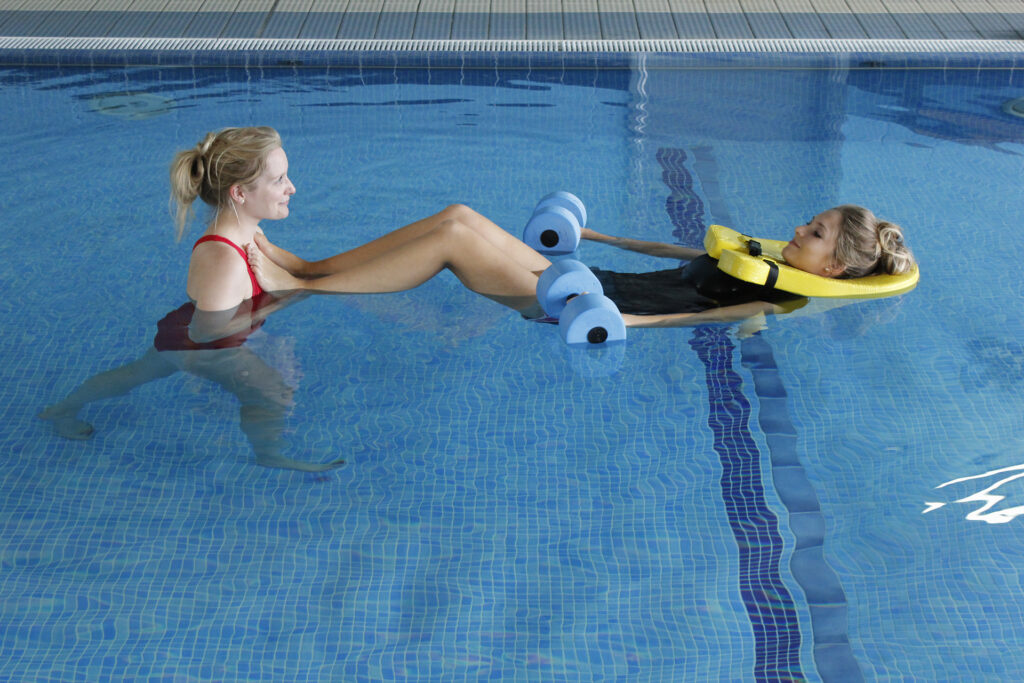Humanity discovered the therapeutic benefits of water and its use in various medical fields. Today, aquatic therapy, particularly swimming therapy, stands out as one of the most important methods of rehabilitation, guiding us on a journey towards healing and recovery from various injuries and illnesses.
“What is aquatic therapy?” Swimming therapy
is a type of physical therapy practiced in water, utilizing the unique properties of water to provide resistance and support for joints and muscles, making it an ideal option for treating a wide range of conditions.
The history of water therapy, including swimming therapy, dates back thousands of years. The earliest documented use of water in therapy dates back to the Roman civilization, where hot baths, cold baths, and pools were used as part of treatment for many health conditions.
Historically, swimming was particularly used in therapy for patients suffering from paralysis or mobility impairments. Ancient medicine used water as a means to alleviate pressure on bones and muscles, easing movement and reducing pain. Over time, our understanding of the benefits of swimming in physical therapy has increased, and the applications have expanded to include many different health conditions.
In the twentieth century, swimming therapy underwent significant development, with new techniques and specialized rehabilitation programs developed to effectively utilize water in treating a variety of conditions, including sports injuries, joint diseases, paralysis, mobility impairments, and post-operative rehabilitation.
Today, swimming therapy is considered an important part of physical therapy and is widely used in physical therapy centers and healthcare facilities around the world.
Benefits of swimming therapy:
- Reduces pain and inflammation: Warm water helps relax muscles and improve circulation, contributing to pain and inflammation relief.
- Improves range of motion: Water resistance provides gentle challenge to joints and muscles, helping improve range of motion, strength, and flexibility.
- Enhances balance and coordination: Walking in water helps improve balance and coordination, reducing the risk of falls.
- Strengthens muscles: Resistance exercises in water are effective in building muscle strength and improving endurance.
- Safe and effective: Swimming therapy is considered a safe and effective option for most people, including seniors, children, and individuals with injuries or chronic diseases.

Uses of Aquatic Therapy:
Rehabilitation after Injuries: Aquatic therapy helps in recovering from sports injuries, bone and joint injuries, spinal cord injuries, and others.
Chronic Conditions: Aquatic therapy can be used to manage symptoms of chronic diseases such as arthritis, asthma, and multiple sclerosis.
Improving Fitness: Aquatic therapy is an excellent activity to improve fitness and overall health.
Stress Relief: Warm water helps in relaxation and reducing stress and anxiety.
Is Aquatic Therapy Suitable for You?
Aquatic therapy helps treat many conditions, including some common examples:
Injuries:
Bone and Joint Injuries: Aquatic therapy helps in pain relief and improving range of motion and strength after injuries such as fractures, sprains, and tears.
Ligament and Tendon Injuries: Aquatic therapy can aid in rehabilitating injured ligaments and tendons, such as ankle sprains or thigh muscle tears.
Chronic Diseases:
Arthritis: Aquatic therapy helps in relieving arthritis pain and improving movement and function. Fibromyalgia: Aquatic therapy can alleviate muscle pains, fatigue, and improve sleep quality. Multiple Sclerosis: Aquatic therapy improves balance, coordination, and strength in individuals with multiple sclerosis.
Neurological Conditions:
Stroke: Aquatic therapy aids in rehabilitating the affected side of the body after a stroke and improves balance and coordination. Brain Injuries: Aquatic therapy can improve movement and function in individuals with brain injuries. Cerebral Palsy: Aquatic therapy improves movement, coordination, and strength in children with cerebral palsy.
Other Conditions:
Chronic Pain: Aquatic therapy can relieve chronic pain and improve quality of life. Obesity: Aquatic therapy helps burn calories and improve fitness for individuals with obesity. Rehabilitation after Surgery: Aquatic therapy aids in recovery after surgery and improves range of motion and strength.
In conclusion, it’s important to note that these are just a few examples of conditions that can benefit from aquatic therapy. Your therapist will evaluate your needs and design a treatment plan that suits you.
Which Conditions Can Aquatic Therapy Help?
If you are suffering from an injury or illness or looking for a way to improve your physical fitness and overall health, aquatic therapy may be a suitable option for you. Consult your doctor or physical therapist to determine if this type of treatment is appropriate for your condition.
The conditions that aquatic therapy can help with include:
Muscle and Joint Pain: Aquatic therapy can alleviate pain and swelling in muscles and joints and increase their flexibility. Stress and Anxiety: Relaxation in water can help reduce stress and anxiety and increase mental relaxation. Improved Circulation: Aquatic therapy can enhance blood flow and improve circulation throughout the body. Detoxification: Hot and cold water can stimulate the body’s natural cleansing process and help eliminate toxins. Improved Sleep: Bathing in warm water before sleep can improve sleep quality and increase relaxation. Back Pain: Aquatic therapy can alleviate pain in the back area and improve spinal condition. Muscle Strengthening: Exercising in water can strengthen muscles and increase fitness without impacting the joints.
What Are the Methods of Aquatic Therapy?
There are several different methods of aquatic therapy, including traditional techniques and those utilizing modern technology. Among these methods are:
Swimming: Swimming is one of the most popular and widely used forms of aquatic therapy. Swimming can help strengthen muscles, improve fitness, and relieve stress. Relaxation in Hot Tubs: Relaxing in a hot tub pool (jacuzzi) is a common form of aquatic therapy. Heat and water massage can help relax tense muscles and reduce pain. Water Exercises: Special exercises can be designed to be performed in water to improve muscle strength and flexibility. These exercises vary from gentle to vigorous according to individual needs and abilities. Hydrotherapy Massage: Hydrotherapy massage uses mechanical devices or water energy to target massage to the affected parts of the body, which can help relieve tension and pain. Aquatic Rehabilitation Exercises: Aquatic therapy can be used as part of medical rehabilitation programs for individuals recovering from injuries or surgeries, where specific exercises are performed to improve movement and strength under the supervision of specialists. Stretching and Extension in Water: Aquatic therapy can be used to relieve pressure on joints and the spine by stretching and moving the body in water.
In Which Cases Should Aquatic Therapy Not Be Performed?
Despite its many benefits, aquatic therapy may not be suitable for everyone, and aquatic therapy should be avoided in the following cases:
Open Wounds or Infections: Water entry may introduce bacteria into wounds and worsen infections. Unstable Cardiac or Pulmonary Conditions: Exercise in water may strain the heart or lungs. Neurological Conditions Affecting Muscle Control: It may increase the risk of falls or drowning. Certain Skin Conditions: Some skin conditions like eczema or psoriasis may be aggravated. Fever: Fever may exacerbate fatigue and weaken the body. Inability to Swim or Fear of Water: Anxiety or fear of water may make the experience uncomfortable or dangerous.
It’s important to consult a doctor before starting any aquatic therapy program, especially if you have any medical condition.
In conclusion, aquatic therapy is a powerful tool that can help you achieve your health goals and improve your quality of life.

